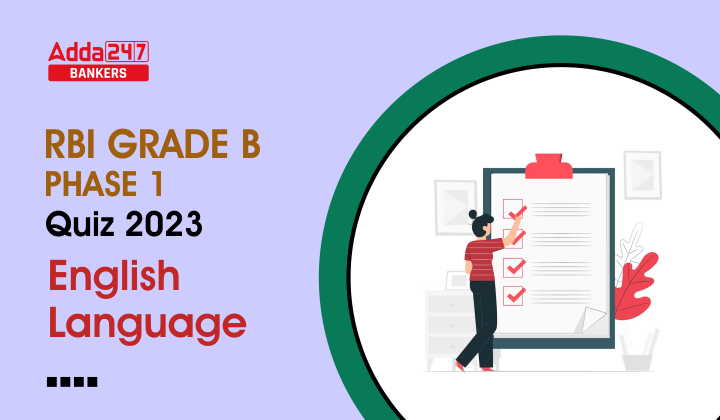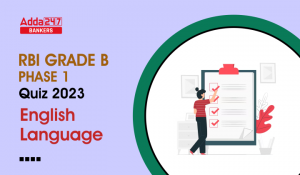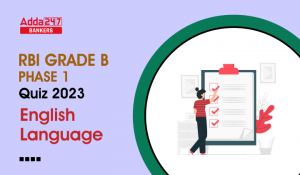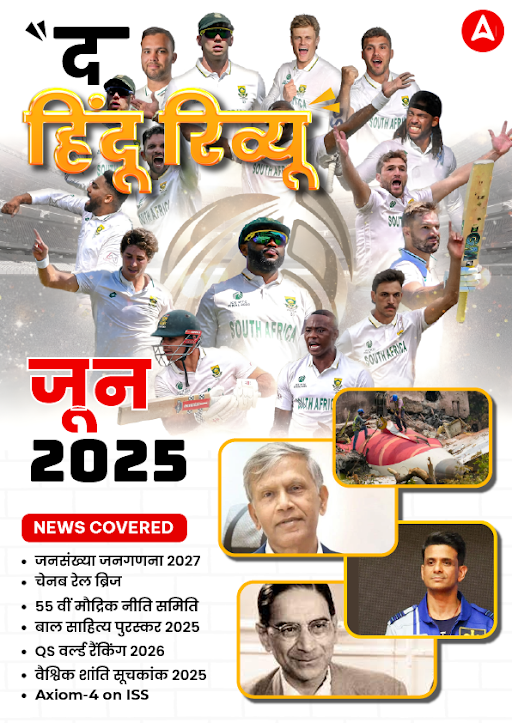Directions (1-5): In the following questions, there is a statement divided into five parts, when arranged properly forms a coherent sentence both grammatically and contextually. The first part of the statement is given in bold to help you rearrange the other parts accordingly. Choose the best alternative among the five options given below each statement as your answer.
Q1. Forty-five years after / the Central government has allowed (A)/the re-entry of commercial mining (B)/firms into the sector, turning the clock back (C)/ India nationalised its coal-mining industry, (D)
(a)BADC
(b)BCDA
(c)DABC
(d)CDBA
(e)No rearrangement required
Q2. What motivated /three-time chief minister Rio to quit the post (A)/ and contest the 2014 parliamentary poll was his ambition (B)/to become a Central cabinet minister (C)/ after serving for 11 years (D)
(a)ADBC
(b)BCDA
(c)CBDA
(d)DABC
(e)No rearrangement required
Q3. For many years the Royal Indian Navy (RIN) Mutiny, / remained largely marginal in the narratives of modern Indian history (A)/ and lasted a mere five days before the leaders (B)/ which broke out in full swing on February 18, 1946, (C)/ who acted on behalf of the disaffected soldiers surrendered, (D)
(a)DBCA
(b)CBDA
(c)BACD
(d)DABC
(e)No rearrangement required
Q4. Naga politicians claim /they are serious about early peaceful settlement of the Naga problem, (A)/but what they are exhibiting now (B)/is not so much the craving for lasting peace (C)/as leadership for supremacy (D)
(a)DBAC
(b)CBAD
(c)CDAB
(d)ABDC
(e)No rearrangement required
Q5. Arundhati Bhattacharya, /the first woman to head the country’s largest bank, (A)/ seamlessly implemented a number of (B)/ State Bank of India, (C)/path-breaking changes in the banking sector (D)
(a)BDCA
(b)CABD
(c)ACBD
(d)BACD
(e)No rearrangement required
Directions (6-7): Given below the sentences each of which has been divided into four parts Each of the questions is then followed by the five options which give the sequence of the rearranged parts. You must choose the option which gives the correct sequence of the parts. If the sentence is already arranged in the correct sequence or the correct sequence doesn’t match with any of the given sequence, mark option (e).i.e. “None of the above” as your answer.
Q6. allies in the region which gives it a (A)/and an expanded network of proxies and (B)/ Iran has hybrid warfare capabilities (C)/sharpened capacity to practise its hegemony.(D)/ No arrangement required (E)
(a) CDBA
(b) CBAD
(c) DCBA
(d) DABC
(e) None of the above
Q7. to make sense of the government’s claims ( (A)/ the media takes the lead in B)/through the clutter of official rhetoric (C)/ providing credible information and cuts (D)/ No arrangement required (E)
(a) BDAC
(b) BACD
(c) ACBD
(d) BDCA
(e) None of the above
Directions (8-15): In each of the given questions a statement is given in bold which is then followed by three paragraphs. You have to find the paragraph(s) from where it is inferred. Choose the option with the best possible outcome as your choice.
Q8.
The PCI must act in the interest of a free media and not kowtow to the government.
(I) The Press Council of India (PCI)’s support of government restrictions on communication last week was brazenly contrary to its mandate and purpose. It has sought to intervene in a petition by Kashmir Times executive editor Anuradha Bhasin, pending before the apex court, seeking an end to the restrictions on communication in Jammu and Kashmir that were imposed before the Government’s decision on August 5 to revoke the special constitutional status of the erstwhile State.
(II) The PCI’s stance in the instant case goes against the letter and spirit of this claim. Its track record may not have been stellar; nevertheless, its interventions occasionally held the mirror to deviant journalists and publications and, at the same time, sought to shield the profession and professionals from the highhandedness of the state and non-state actors.
(III) Mr. Malik said whenever there was a crisis in Kashmir in the past; at least 50 people would die by the first week. “Our attitude is that there should be no loss of human life. If there is no phone connection for 10 days, so be it. But, we will restore everything soon. In fact, we delivered meat, vegetables and eggs to people’s doorsteps on Id,” he said.
(a) Only [I] (b) Only [II] (c) Only [III] (d) Both [I] & [III] (e) None of these
Q9.
The rupee is falling, but it is too early to start worrying
(I) In fact, the fall will make India’s exporters competitive. Economists often complain that the rupee is over-valued in terms of the real effective exchange rate making exports uncompetitive. Interestingly, the Reserve Bank of India does not appear to have intervened in support of the rupee, signalling that it is not comfortable with the fall.
(II) The fall in the rupee is, of course, influenced to some extent by the overall economic slowdown and the sell-out in the equity markets in the last couple of months leading to capital withdrawal by foreign portfolio investors. The capital outflow particularly has hit the currency’s valuation. But the fall is no cause for alarm as yet because there is stability on the external account with the current account deficit at a comfortable 0.7% in the quarter ended March 2019.
(III) That judgment in Justice K.S. Puttaswamy (Retd) vs Union Of India fundamentally changed the way in which the government viewed its citizens’ privacy, both in practice and prescription. It undertook structural reforms and brought transparency and openness in the process of commissioning and executing its surveillance projects, and built a mechanism of judicial oversight over surveillance requests
(a) Only [I] (b) Only [II] (c) Only [III] (d) Both [I] & [III] (e) None of these
Q10.
India needs to remind President Trump of the real basis of its claim to J&K
(I) The unfair discrimination against a nascent industry in domestic alternative assets is Exhibit A of the nonstrategic thinking that’s clouding policy-making in India. Exhibit B is the so-called angel tax on startups, a much-hated levy that has finally been removed. The tax was introduced by the previous Congress Party-led government and treated money raised by fledgling firms as income.
(II) India is belatedly acknowledging that something’s gone wrong with what was once billed as the world’s fastest-growing economy. That’s the good news. The bad news is that New Delhi still doesn’t have a cohesive strategy to reverse the slowdown.
(III)Mr. Trump’s assertion that the issue over Kashmir is a religious one unwittingly plays into the Pakistani narrative of a conflict that has defied such narrow definitions for more than 70 years. It is therefore necessary that the government firmly corrects Mr. Trump on the matter.
(a) Only [I]
(b) Only [II]
(c) Only [III]
(d) Both [I] & [III]
(e) None of these
Q11.
In rolling back some measures, the government shows it listens to feedback
(I) The rollback of the capital gains tax imposed in the budget on foreign portfolio investors, the withdrawal of angel tax on start-ups and the promise that non-compliance with corporate social responsibility (CSR) norms will be decriminalised show a government that is willing to listen to feedback from the ground.
(II) The reversal of enhanced surcharge on equity capital gains for foreign and domestic investors was the most anticipated rollback and this should be a sentiment booster. Although the announcement by the finance minister is not a remedy for all the economic woes, it signals a step in the right direction by a government, which is now willing to listen and course-correct.
(III) Emerging market currencies have also been depressed more since the bond yield curve inverted in the U.S. last week when yields on 10-year bonds fell below the two-year note signalling the market’s fear of a recession in the U.S. economy. While there’s no data to support such fears as of now, the trade spat with China seems to be giving the jitters to the market.
(a) Only [I] (b) Only [II] (c) Only [III] (d) Both [I] & [II] (e) None of these
Q12.
The Dunhuang city has been witness to multiple interactions and mutual learning between China and India
(I) Recently, Chinese President Xi Jinping visited the Mogao Grottoes in Dunhuang city of China to inspect cultural relics protection and research work. Some Indian friends may have heard about Dunhuang, but not many know about its unique beauty, history and culture. Here I wish to share with you stories about the Dunhuang that I know.
(II) Dunhuang is a land that has gone through vicissitudes of history with ancient legacies and magic beauty. Around 2,000 years ago, a Chinese geographer of the Eastern Han dynasty Ying Shao said: “Dun, means grand; Huang, means splendid.” Therefore Dunhuang means the land of grand splendour. Historical changes over the millennium shaped the magnificent landscape of this frontier region west of China’s Gansu province and left colourful and gorgeous cultural treasures.
(III) The Mogao Grottoes, located in a desert oasis surrounded by water and mountain, have stood quietly for over 1,650 years and become the most abundant and exquisite Buddhist art relics in China and beyond. Mogao Grottoes are a treasure house of art, architecture, sculpture and painting with 735 grottoes, over 45,000 square meters of murals and 2,000 painted sculptures.
(a) Only [I] (b) Only [II] (c) Only [III] (d) Both [I] & [II] (e) None of these
Q13.
An end to the New START in 2021 will leave the arsenals of the two major nuclear powers unencumbered by any pact
(I) On August 2, the U.S. formally quit the pact. Concluded in 1987, the agreement had obliged the two countries to eliminate all ground-based missiles of ranges between 500 km and 5,500 km, an objective achieved by 1991. At risk is the New START (Strategic Arms Reduction Treaty) signed in 2010 and due to lapse in February 2021.
(II) New START imposes limits on the number of US and Russian long-range nuclear warheads and launchers. The deal was made in 2010, but the limits didn’t take effect until 2018. It is unlikely the administration will agree to the five-year extension to New START that the treaty allows and which can be done without legislative action in either capital.
(III) The Gross Domestic Savings Rate also fell between 2011-12 and 2017-18 by 4.1% points, from 34.6% of GDP to 30.5%. However, this fall was entirely due to the household sector, with the private corporate and public sectors showing increases in their savings rates by margins of 2.2% points and 0.2% points, respectively.
(a) Only [I] (b) Only [II] (c) Only [III] (d) Both [I] & [II] (e) None of these
Q14.
Attention needs to be paid to both cyclical and structural dimensions of India’s present economic slowdown
(I) When it comes to the Gross Fixed Capital Formation (GFCF) relative to GDP at current prices, a steady fall has been visible since 2011-12, when it was 34.3%. By 2017-18, it had fallen by 5.7% points, to a level of 28.6%.Assuming an Incremental Capital Output Ratio (ICOR) of 4, this meant a fall of nearly 1.4% points in the potential growth rate.
(II) India’s current economic slowdown is due to a combination of two underlying trends. First, there is the short-run cyclical slowdown exhibited by a number of high-frequency indicators. Second, there is the more serious long-term fall in investment and savings rates. Raising growth requires that attention be paid to both cyclical and structural dimensions of the problem.
(III) In contrast to the household sector rate, the private corporate sector investment rate did not show any fall up to 2015-16 when, at 11.9%, it was in fact higher than the corresponding rate for 2011-12 (11.2%). It fell in the subsequent years, but only by 0.7% points.
(a) Only [I] (b) Only [II] (c) Only [III] (d) Both [I] & [II] (e) None of these
Q15.
SEBI’s liberalised norms for FPIs will make Indian markets attractive to foreign investors
(I)While the steps taken by policymakers to make amends for their previous policy errors are obviously welcome, they should not deflect attention from the larger and persistent issue of overreach by the government against investors.
(II) Smart cities, along with other urban development agencies, will now be allowed to issue municipal bonds to raise funds for development. These measures to cut red tape will help lower the regulatory burden on investors, globalise India’s financial markets.(III) Foreign investors who have been fleeing the country since the Union budget presented early last month have something to cheer about finally. On Wednesday, the Securities and Exchange Board of India (SEBI), based on the recommendations of the H.R. Khan committee, eased several regulatory restrictions that are likely to make life easier for foreign portfolio investors (FPIs).
(a) Only [I] (b) Only [II] (c) Only [III] (d) Both [I] & [II] (e) None of these
Solutions
S1. Ans. (c)
Sol. The correct sequence to arrange the sentence properly and meaningfully is DABC. The expression “the Central government has allowed the re-entry of commercial mining” gives a contextual meaning to the sentence. Hence option (c) is the correct choice.
“Forty-five years after India nationalised its coal-mining industry, the Central government has allowed the re-entry of commercial mining firms into the sector, turning the clock back.”
S2. Ans. (a)
Sol. The correct sequence to arrange the sentence properly and meaningfully is ADBC. It is to be noted that the expression “What motivated three-time chief minister Rio to quit the post” gives a meaningful sense to the sentence which when followed by the parts D, B and C subsequently make the sentence meaningful. Hence option (a) is the correct choice.
“What motivated three-time chief minister Rio to quit the post after serving for 11 years and contest the 2014 parliamentary poll was his ambition to become a Central cabinet minister.”
S3. Ans. (b)
Sol. The correct sequence to arrange the sentence properly and meaningfully is CBDA. This can be verified by the expression “which broke out in full swing on February 18, 1946, and lasted a mere five days before the leaders” which gives a coherent meaning to the sentence. Hence option (b) is the correct choice.
“For many years the Royal Indian Navy (RIN) Mutiny, which broke out in full swing on February 18, 1946, and lasted a mere five days before the leaders who acted on behalf of the disaffected soldiers surrendered, remained largely marginal in the narratives of modern Indian history.”
S4. Ans. (e)
Sol. The given statement doesn’t require any rearrangement as it already gives a contextual meaning to the sentence. The expression “is not so much the craving for lasting peace as leadership for supremacy” gives the required structure to the sentence. Hence the correct sequence is ABCD.
“Naga politicians claim they are serious about early peaceful settlement of the Naga problem, but what they are exhibiting now is not so much the craving for lasting peace as leadership for supremacy.”
S5. Ans. (c)
Sol. The correct sequence to arrange the sentence properly and meaningfully is ACBD. This can be verified by the expression “the first woman to head the country’s largest bank, State Bank of India,” which gives a coherent meaning to the sentence. Hence option (c) is the correct choice.
“Arundhati Bhattacharya, the first woman to head the country’s largest bank, State Bank of India, seamlessly implemented a number of path-breaking changes in the banking sector.”
S6. Ans. (b)
Sol. The correct arrangement is, ‘Iran has hybrid warfare capabilities and an expanded network of proxies and allies in the region which gives it a sharpened capacity to practice its hegemony.’
S7. Ans. (d)
Sol. The correct rearrangement is, ‘The media takes the lead in providing credible information and cuts through the clutter of official rhetoric to make sense of the government’s claims.’
S8. Ans. (a)
Sol. Among the paragraphs given above, only paragraph [I] clearly justifies the given inference. Hence, option (a) is the most suitable answer choice.
S9. Ans. (b)
Sol. Among the paragraphs given above, only paragraph [II] clearly justifies the given inference. Hence, option (b) is the most suitable answer choice.
S10. Ans. (c)
Sol. Among the paragraphs given above, only paragraph [III] clearly justifies the given inference. Hence, option (c) is the most suitable answer choice.
S11. Ans. (d)
Sol. Among the paragraphs given above, both paragraph [I] and [II] clearly justify the given inference. Hence, option (d) is the most suitable answer choice.
S12. Ans. (e)
Sol. Among the paragraphs given above, no paragraph justifies the given inference. Hence, option (e) is the most suitable answer choice.
S13. Ans. (a)
Sol. Among the paragraphs given above, only paragraph (I) justifies the given inference. Hence, option (a) is the most suitable answer choice.
S14. Ans. (b)
Sol. Among the paragraphs given above, only paragraph (II) justifies the given inference. Hence, option (b) is the most suitable answer choice.
S15. Ans. (c)
Sol. Among the paragraphs given above, only paragraph (III) justifies the given inference. Hence, option (c) is the most suitable answer choice.
Click Here to Register for Bank Exams 2021 Preparation Material





 English Language Quiz For For RBI Grade ...
English Language Quiz For For RBI Grade ...
 English Language Quiz For For RBI Grade ...
English Language Quiz For For RBI Grade ...
 English Language Quiz For For RBI Grade ...
English Language Quiz For For RBI Grade ...

